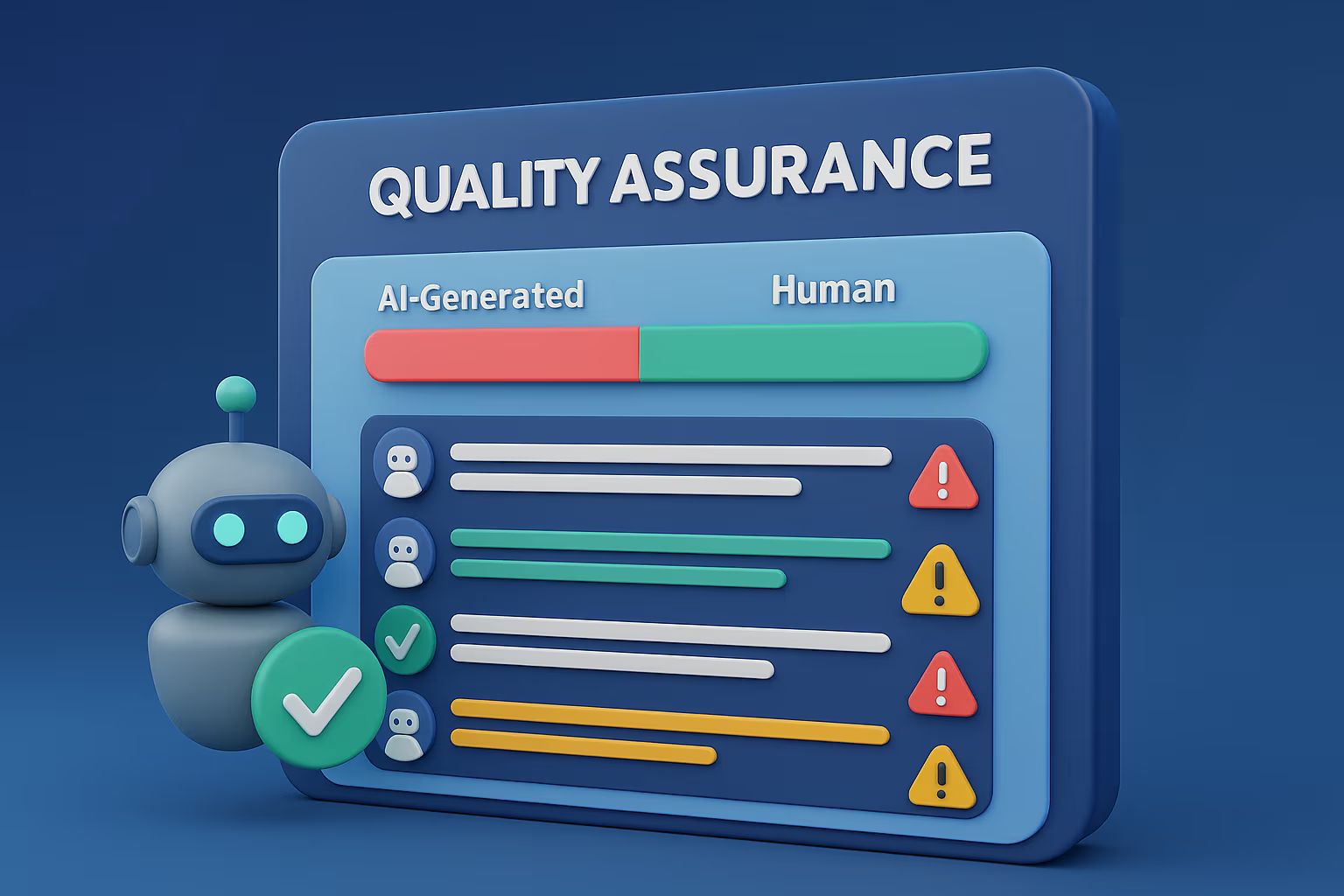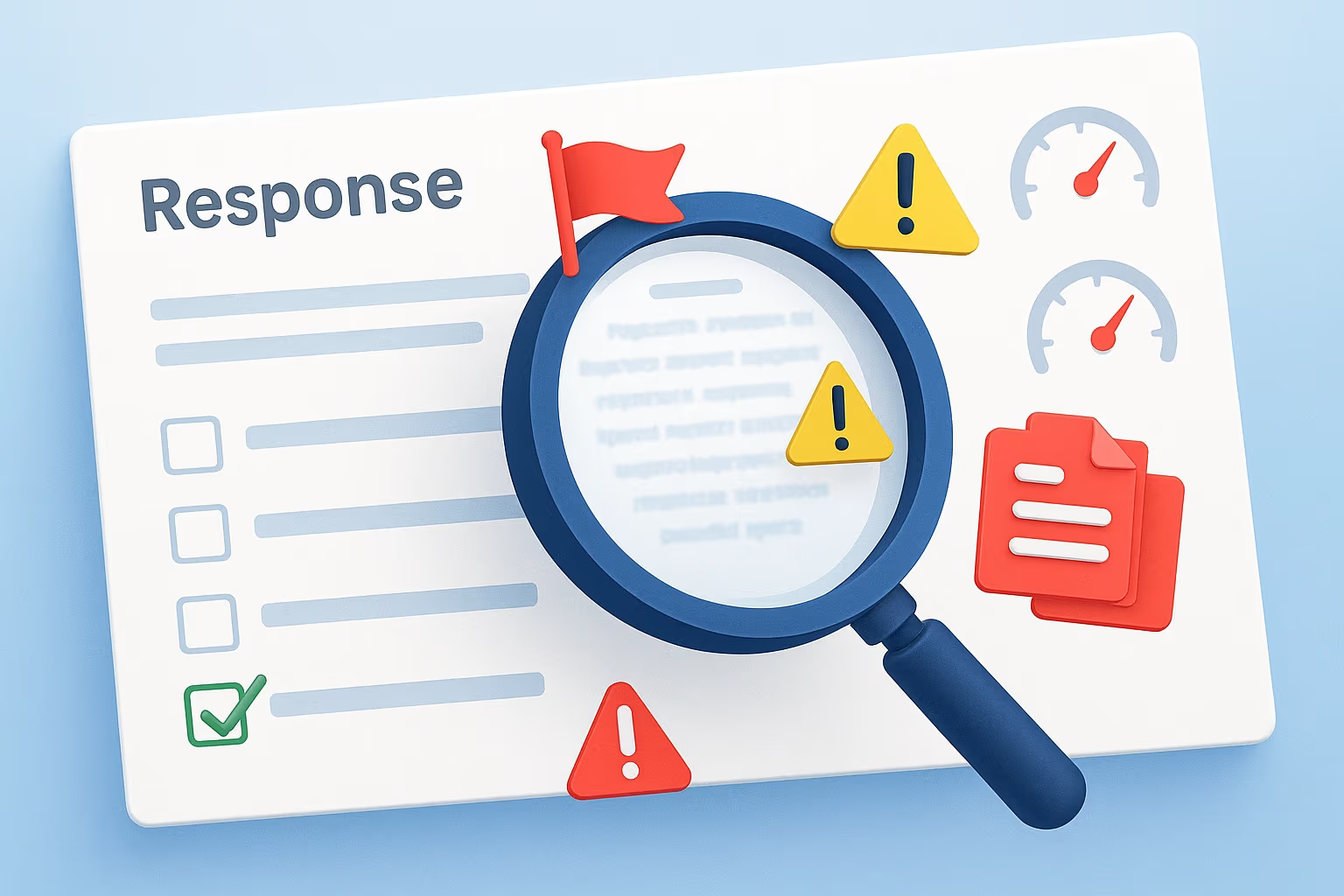Online surveys have rapidly become a cornerstone for both research and business, offering organizations a fast, affordable, and scalable way to gather insights from diverse audiences. Leading companies like Amazon, Nike, and Tesla rely on online surveys to refine products, optimize services, and stay ahead in competitive markets.
The flexibility, accessibility, and high response rates of digital surveys have transformed how decisions are made across industries.
However, this surge in online data collection brings new challenges—most notably, the rise of AI-generated and bot responses that can pollute survey datasets. As AI tools become more sophisticated, malicious actors can generate fake, human-like responses that easily bypass traditional anti-bot checks.
These synthetic entries can distort results, introduce bias, and undermine the reliability of research, making it increasingly difficult for organizations to trust their data.
In the age of AI, robust data quality assurance is more critical than ever. High-quality, accurate data is the fuel that powers reliable insights and effective decision-making. Without rigorous validation and quality controls, flawed or manipulated data can lead to misguided strategies and costly mistakes.
As organizations embrace AI-driven research, prioritizing data integrity is essential to unlock meaningful, trustworthy insights and maintain a competitive edge.
The Rise of AI-Generated Survey Responses

What are AI-generated and bot survey responses?
AI-generated and bot survey responses are answers to online surveys produced not by genuine human participants, but by automated systems or artificial intelligence tools. Survey bots are programmed to fill out forms rapidly, often mimicking human patterns to avoid detection, while generative AI tools like ChatGPT can craft responses that appear thoughtful and nuanced—even for open-ended questions.
These technologies can generate large volumes of responses with little to no human oversight, making it challenging to distinguish authentic feedback from synthetic or fraudulent entries.
Why are they becoming more prevalent?
Several factors are driving the surge in AI-generated and bot responses:
a. Incentives and Rewards: Many online surveys offer monetary compensation, gift cards, or other incentives. This attracts not only genuine participants but also individuals or groups using bots and AI tools to maximize earnings with minimal effort.
b. Ease of Automation: Advances in AI and automation have lowered the technical barriers, making it easier for anyone to deploy bots or use AI to fill out surveys at scale. Even individuals with limited programming knowledge can now access tools that generate convincing responses.
c. Malicious Intent: Some actors deliberately use bots to skew survey results, manipulate research outcomes, or sabotage competitors. This can have significant consequences for businesses and researchers relying on accurate data.
Real-world examples and incidents
The impact of AI-generated responses is already being felt across industries:
A Stanford study found that a third of online survey takers admitted to using AI tools like ChatGPT to answer questions, raising concerns about the authenticity and reliability of academic research.
Researchers have noticed open-ended survey responses that appear "too perfect": longer, grammatically flawless, and lacking the typical human quirks or emotional tone—clear signs of AI involvement.
Experiments using AI tools such as ChatGPT and Copilot to answer qualitative survey questions have shown that even advanced AI-detection algorithms often fail to flag these responses, leading to both false negatives (AI responses passing as human) and false positives (authentic responses flagged as AI).
Survey bot fraud is not limited to large-scale attacks. With AI tools widely accessible, even individuals can now generate synthetic responses, increasing the frequency and unpredictability of survey fraud.
As AI and automation continue to evolve, the challenge of identifying and mitigating AI-generated survey responses is becoming a critical concern for anyone relying on online survey data. Without effective safeguards, these synthetic responses threaten the validity and usefulness of research and business insights.

Why AI-Generated Responses Threaten Data Quality
Impact on Survey Validity and Reliability
AI-generated and bot responses undermine the core principles of survey research—validity and reliability. These synthetic entries often fail to reflect genuine human opinions, motivations, or experiences, leading to data that does not accurately represent the target population. When AI-generated responses are included in analysis, they can distort findings, making research less accurate and, as some experts note, "a lot less interesting".
How Synthetic Responses Skew Results and Mislead Stakeholders
Distorted Insights: AI-generated responses can introduce artificial patterns or uniformity, masking real trends and nuances in the data. This can lead to misleading conclusions and poor strategic decisions.
Resource Waste: Time, money, and effort spent analyzing flawed data ultimately yield unreliable insights, wasting resources and potentially resulting in costly business or policy errors.
Stakeholder Misinformation: Decision-makers relying on tainted data may be misled about customer needs, market trends, or research outcomes, which can have far-reaching negative consequences.
Comparison with Traditional Survey Quality Threats
Traditional threats to survey quality include inattentive human respondents, straightlining (selecting the same response for all questions), and random answering. While these issues compromise data integrity, they are often easier to detect and correct through established quality checks and attention filters. In contrast, AI-generated responses can mimic thoughtful human answers, pass basic validation, and even evade advanced detection methods, making them a more insidious and challenging threat.
Moreover, the scale and speed at which AI can generate responses far exceed what inattentive humans could produce, amplifying the risk to data quality. As a result, the presence of AI-generated responses requires new, more sophisticated validation strategies to ensure the integrity and reliability of survey data in the AI era.
In summary, while traditional data quality threats remain relevant, the rise of AI-generated responses introduces a new level of complexity and risk, demanding robust, adaptive quality assurance measures to maintain trustworthy survey results.

Key Indicators of AI-Generated Survey Responses
As AI-generated and bot survey responses become more sophisticated, recognizing their telltale signs is critical for maintaining data quality. Here are some of the most common red flags:
Unnaturally Fast Completion Times:
AI and bots can process and submit entire surveys in seconds—far faster than a typical human respondent. If you notice submissions with implausibly short completion times, these are likely synthetic responses.
Highly Consistent or Patterned Answers:
AI-generated responses often exhibit repetitive or uniform patterns, such as selecting the same option across multiple questions or providing similar ratings throughout the survey. This lack of natural variability can signal automation.
Lack of Variance in Open-Ended Responses:
When reviewing open-ended questions, AI-generated answers may appear overly consistent in length, structure, or phrasing. For example, every response might be a perfectly formed sentence or paragraph, with little variation in style or detail.
Use of Advanced Language or Generic Phrasing:
AI tools tend to produce grammatically flawless, formal, and sometimes generic responses. Phrases may sound polished but lack personal anecdotes or emotional nuance—hallmarks of genuine human feedback.
Examples of Suspicious Response Patterns
Example 1:
A batch of 100 survey responses is received within five minutes, all with completion times under 30 seconds.
Example 2:
Open-ended answers such as, “The product exceeded my expectations in every way. I highly recommend it for its outstanding quality and performance,” are repeated verbatim or with only minor changes across many submissions.
Example 3:
Multiple-choice questions show the same answer selected across a large number of responses, or a pattern emerges (e.g., always choosing the first or last option).
Example 4:
Responses to nuanced or subjective questions are consistently generic, such as, “I am satisfied with the service,” without any elaboration or specific examples.
Spotting these patterns is the first step in flagging suspect data and ensuring your survey results remain credible and actionable.
Custom Validation and Quality Control Strategies
Setting Up Custom Validation Rules
Custom validation rules are essential for flagging suspect survey responses and maintaining data integrity, especially as AI-generated and inattentive entries become more prevalent. With platforms like BioBrain, you can define tailored criteria to automatically flag responses that deviate from expected norms.
Trap Questions and Attention Checks
Trap questions (also known as attention checks or instructional manipulation checks) are strategically placed items designed to catch inattentive or automated respondents. These questions typically have an obvious correct answer or specific instruction, such as “Select option D for this question.” Respondents who fail these questions are likely not reading carefully or may be bots. Incorporating multiple trap questions throughout the survey can significantly improve data quality by filtering out low-effort or automated responses.
Logic Checks and Response Pattern Analysis
Logic checks ensure that responses follow a logical flow, catching inconsistencies or contradictions. For example, if a respondent answers “No” to having children but later provides ages for their children, this inconsistency can be flagged for review. Response pattern analysis looks for suspicious trends, such as straightlining (selecting the same answer for every question) or a lack of variance in open-ended responses, both of which can indicate automation or disengagement.
Importance of Pilot Testing and Ongoing Monitoring
Pilot testing your survey with a small group before full deployment helps identify potential issues with question clarity, logic flows, and the effectiveness of validation rules. Ongoing monitoring—through high-frequency data checks and regular review of flagged responses—ensures that emerging threats, such as new AI-generated response patterns, are detected and addressed promptly.
BioBrain’s Approach: Custom Validation and AI Detection
BioBrain enhances traditional quality control with advanced, customizable validation and AI-detection capabilities. Users can configure rules to flag or filter responses based on speed, answer patterns, or even linguistic features typical of AI-generated text. BioBrain’s AI-detection algorithms analyze open-ended responses for unnatural consistency, advanced language, or generic phrasing, providing an additional layer of protection against synthetic data.
By combining trap questions, logic checks, response pattern analysis, and AI-powered validation, BioBrain empowers researchers and businesses to maintain high data quality—even as survey fraud and automation threats evolve.
In a landscape shaped by rapid AI advancement, future-proofing survey data quality demands adaptability, ongoing learning, and strong collaboration. By embracing these principles, organizations can ensure their survey insights remain trustworthy and actionable, no matter how the technology evolves.










